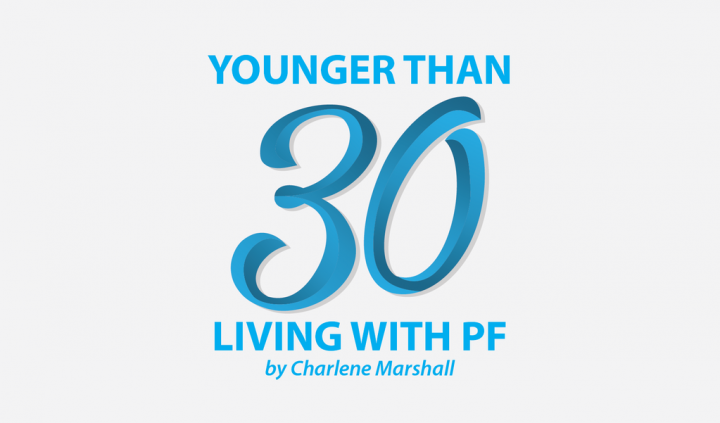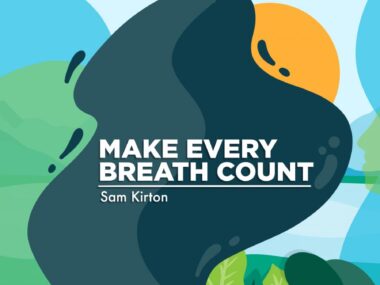How Much Risk Can Pulmonary Fibrosis Patients Mitigate?
Written by |

The world must learn to address our widespread anxiety about the ongoing health crisis. As a patient living with idiopathic pulmonary fibrosis (IPF), a life-threatening lung disease that makes me increasingly vulnerable to respiratory infections, I’m familiar with this anxiety. But life must continue, and it’s necessary to find a balance between anxiety and being realistic about our new reality.
At the same time, it’s important to mitigate risk as a patient with a chronic illness. Sometimes I wonder if it’s ever truly possible to do this while living with IPF.
Since my diagnosis four years ago, much of my time and energy is spent on trying to care for my mental, physical, and emotional health by avoiding unnecessary risks for my lungs. How that looks each day is a little different. For example, I am always on the lookout for people smoking in public places in an effort to ensure I avoid inhaling their secondhand smoke. Being on alert all the time is exhausting, but it is necessary to protect my lungs.
The efforts to mitigate risk and avoid getting sick that many of us with a chronic illness make every day is becoming normalized amid our global health crisis. A friend recently shared with me that current events have helped her have empathy and gain insight into the efforts required to stay safe as a chronically ill patient. While I wish no one had to understand this based on experience, it is comforting to know that people are becoming aware of all the risks we face as patients living with IPF.
Some of these things include acute exacerbations, sudden disease progression, and increased susceptibility to illness due to being immunocompromised.
While awareness of risk is important, sometimes despite all our efforts, the risks associated with having a life-threatening lung disease can’t be mitigated entirely. I am currently pondering a decision I know could be risky, and I’m thinking of every possible solution to help keep me safe. At some point, though, I have to let go and accept that life must go on, and that my efforts may not be enough to protect me. Does that mean that I should stop living my life and decline opportunities? I don’t believe it does.
I am a strong advocate for learning to live with IPF, which means not letting my disease dictate my life and working hard to do the things that are important to me, even if modifications are required. This includes things like traveling, working, and spending time with friends and family. While there are varying degrees of risk associated with each of these things, I don’t want to become a passive patient.
There are many clichés about the importance of living each day as if it were your last, because none of us are guaranteed another day. I am often guilty of saying things like, “We could be hit by a bus tomorrow,” or “None of us are getting out of this alive.”
I usually say these things when I’m encouraging people to live a quality life, but I know mitigating risk whenever possible and doing things safely is important. The years I’m guaranteed likely are fewer than those of my peers, so I simply don’t want to spend time always worrying about risks associated with things I love to do.
As I continue to determine what is safe and what is a risk, I lean more toward thinking there is always risk with my disease, and I don’t think it is possible to mitigate that entirely as a patient living with IPF. Unfortunately, that is just my reality, and I can only be as proactive as possible in thinking about scenarios that could occur, and putting steps in place to respond to them. At some point, I must let go and accept that ultimately, my fate is out of my control.
What are some of the ways you try to mitigate risk as a patient living with IPF/PF? In our current situation, something we all can do to help mitigate risk for ourselves and one another is to regularly wash our hands.
***
Note: Pulmonary Fibrosis News is strictly a news and information website about the disease. It does not provide medical advice, diagnosis, or treatment. This content is not intended to be a substitute for professional medical advice, diagnosis, or treatment. Always seek the advice of your physician or other qualified health provider with any questions you may have regarding a medical condition. Never disregard professional medical advice or delay in seeking it because of something you have read on this website. The opinions expressed in this column are not those of Pulmonary Fibrosis News or its parent company, Bionews, and are intended to spark discussion about issues pertaining to pulmonary fibrosis.







Cheryl Thomas
Hi Charlene
I too have IPF. I was recently diagnosed. So far mot symptomatic. I am 65 much older than you. But was otherwise healthy. I was swimming a mile 3 x a week intil the virus. Wanted to know if you are taking one of the medications and did you have a lung biopsy for diagnosis? Would love to hear from you.
Charlene Marshall
Hi Cheryl,
Thanks so much for reading my columns and reaching out via the comments. Sorry to hear of your IPF diagnosis as well, but glad you remain symptom free. Kudos to you for swimming still! I love to swim, and find it very helpful for my breathing and overall strength. I am on Ofev (150mg twice daily... it took me some time for my body to adjust to this drug) and I did not have a lung biopsy for diagnosis. Hope this helps! :)
Char.
Robert Tih
Hi Charlene
I was diagnosed with IPF about eight years ago.
For the first seven years a Respirologist followed my condition with annual follow up, PFT and 6 minute walk. I had 3 CT scans the first scan confirmed my IPF diagnosis. The second scan four years ago confirmed that my condition had remained relatively stable with no significant deterioration. Over the last 12 months I noticed I became short of breath more easily than before.
Six months ago at my annual follow up my Respirologist confirmed my PFT Showed significant decline. He ordered a HDCT scan, which was done two weeks ago and I am scheduled for a PFT and 6 minute walk and follow up with my respirologist mid September.
I use a finger tip Oximeter and my oxygen is around 92 to 96 at rest. Heart rate 70-75. When I walk around the house my heart rate increases significantly, easily to 85 or 90 plus. Oxygen drops to around 90 but quickly recovers to
92-96 within a minute when I sit down.
Up until a week ago, if I walked briskly my oxygen would drop to 88-90. My heart rate would increase to 100-105 and then oxygen would also increase to a little over 90. All this is logical to me. I exercise, oxygen Level goes down, heart beat increases to compensate.
Over the last week this has changed. When I walk briskly, my oxygen level keeps dropping and dropping to as low as 70 and my heart rate stays at 60-65. If I ignore the oxygen level and keep walking briskly my heart rate will go up after five minutes so and my oxygen will increase to around 80-85. But not higher.
If I sit down and rest, after a few minutes oxygen will rise to 90-93. When this happens, I don’t have any physical discomfort.
My question is, has anyone else experienced this?
If your body needs more oxygen heart rate should increase almost immediately. In my case, there is about a five minute delay before my heart beat increases. If you have experienced this please share your experience. I’m seeing my respirologist next month and I will share what he has has to say with everyone.
As we all go through the daily challenge of living with IPF sharing our experience with each other
may be helpful.
Best of luck to everyone
Robert
Charlene Marshall
Hi Robert,
Thanks so much for reading my columns and reaching out via the comments. Sorry to hear you've been dealing with this cruel lung disease for eight years now, though the last year sounds the most challenging! I'm glad you have a Respirologist following you closely and hopefully monitoring the decline and your unpleasant symptoms. Are you on either of the two anti-fibrotics to try and help slow progression? The 02 saturations in the 70s must feel awful, I'm so sorry you're experiencing that. I can't say I've had an experience similar to what you describe Robert, so unfortunately I can't share any personal stories about this, but definitely good to ask your Respirologist. Let us know what he/she says. This might however, be a good question to ask in our forums to see if anyone there has experienced something similar:http://pulmonaryfibrosisnews.com/forums/ ... I know I find it so comforting to connect with other patients about things. Thanks for writing and keep in touch!
Char.
Martha Atenas
Hola mi nombre es Martha, padezco fibrosis pulmonar desde hace 8 o 9 años, y me pasa exactamente lo mismo que a ti respecto a la oxigenación y frecuencia cardiaca, durante estos años estuve controlada, pero hace tres semanas tuve problemas para respirar y me han puesto oxígeno la gran parte del día, estoy en revisión con los médicos por ahora, pero me dicen que ya debo de estar siempre conectada al oxígeno
Charlene Marshall
Hola martha
Gracias por escribir y compartir su experiencia con nosotros. Lamento mucho oír hablar de su dependencia del oxígeno ahora, qué cruel enfermedad pulmonar es esta. Espero que pueda recuperarse de su revés y seguir haciéndolo lo mejor posible.
Sinceramente,
Charlene.
Allan
Thanks for that info, I observe my coughing is becoming more recurrent
and anti cough medication not working effectively live before.
Cheryl
Yes it did help. I will not have a lung biopsy either. I will start the Esbriet and hope my body can handle any of the many side effects. Thanks for getting back to me!
Bruce Ruedebusch
I am wondering how many others have had to learn to live with their oxygen requirements, with even light activity,is over 10 litres. I was diagnosed with copd and IPF 6 years ago and have been on oxygen 24/7 for almost 4 years. Definitely alot to learn still about this deceise.
Charlene Marshall
Hi Bruce,
Thanks so much for reading my columns and reaching out via the comments. Many of us living with IPF/PF have unfortunately had to adapt or learn to use supplemental 02, though I don't have personal experience with 10 LPM. Some members of the forums can likely chat with you about this though. Are you part of our forums community? You can join here if not: http://pulmonaryfibrosisnews.com/forums/
There's lots to learn about IPF/PF and the forums community is a great platform for that!
Sincerely,
Charlene.
Mike fryman
Wow, I am 69, newly dx, full O2....upping Ofev tomorrow to 150, hard to be so tethered to O2, such increased fatigue though I have good days! Wonder what Ofev will alter! I am also on cellcept, I do miss being more active—but nice to be alive! Retired disabled army nurse so have lived with pain, but never experience with IPF! Just don’t know, very confused about pulse ox, sometimes can go on treadmill and other times pulse ox 75 after 2 min! Very confused! Anyway, hang tough and wish you all good energy!
Charlene Marshall
Hang in there as well Mike, thanks for writing!
Wishing you the very best.
Char.
Cindy
I understand where you are coming from. My husband was diagnosed with PF in 2013. Even when he went on oxygen in 2016, we got a portable machine and still did some traveling. Now that he is at 8-10 lpm 24/7 our going is limited. And now with the covid, we pick and choose carefully where we go. Two weeks ago we dicided that we were definitely going to attend our granddaughter's wedding and reception. That was a goal he wanted to reach. We went and had a wonderful time. I pray every day that he or no one else doesn't get sick. I agree that you need to live everyday doing what you enjoy. Sure we don't need to take foolish risks, but being at that wedding was giving him something to look forward to. Now he has another goal. To attend our granddaughter's graduation from pharmacy school next May. I think it's important to set goals for yourself. Charlene, keep up the fight. Always, appreciate your comments.
Charlene Marshall
Hi Cindy,
Thanks so much for reading my column and reaching out via the comments. Sorry to hear though, that you and your husband are navigating this cruel lung disease! I'm glad to hear you're being choosy about where to go right now amid the current pandemic, things are really scary and I'm feeling the anxiousness and nerves associated with traveling as a patient with IPF. I hope neither of you get sick either from the wedding reception, but what a beautiful milestone for you both and your granddaughter too: these quality moments are so precious! I'll keep my fingers crossed that he can attend the graduation next spring and that the COVID scenario is very different by then. Thank you for writing and take good care Cindy!
Kind regards,
Char.
Julie Swope
I believe that being on oxygen 24/7 for the last two years prepared me well for the pandemic. Ironically, I feel more normal, because other people are limited in their traveling and social interaction. Before that I felt like I was the only one to have to give up major independence. I’m awaiting a lung transplant and am so grateful that I was healthy enough to get to this stage. I’m on 6 liters of o2 when resting and ten liters upon exertion. I recently talked with my Dr. about a back up plan when I am needing 10 liters when resting and I realize there can be more resources available in a hospital. Being more informed has helped ease my anxiety.
Charlene Marshall
Hi Julie,
Thanks so much for writing - really interesting perspective, and certainly one I can relate to! Being informed - "knowledge is power" - really helps me feel less anxious too. I like to collect all the information and then make an informed decision. In additional to people limiting their socialization and travel, which is what we're used to doing, I also feel a bit more normal with others wearing masks now too. Isn't that a strange way to feel? Best wishes for your wait for transplantation, I'll be thinking of you! Please keep in touch and thanks for sharing this perspective, a great one to consider for many of us.
Sincerely,
Charlene.
Mike Fryman
I am also an ipf dude, dx about 5 months ago on 02 24/7.... i desat pretty quick if off oxygen. Have been on Ofev for month, remain occasional heavy coughing episodes, but am easily faigued with activity. i live in colorado about 6900ft alt. does anyone have experience with altitude. Was told by doc going to sea level for any time would betterrible if i return home. Anyway trying to learn as much as i can, i sleep on full time 02 and use portable units (on demand 02) when active. I just don't have much energy. thanks, Mike
Charlene Marshall
Hi Mike,
Thanks so much for reading my columns and reaching out via the comments. Sorry to hear you're also dealing with this cruel lung disease! How are you tolerating the Ofev thus far? It took me quite awhile to adjust to it and be able to take it. If I recall correctly, there has been some discussion on the PF forums ( http://pulmonaryfibrosisnews.com/forums/ ) about altitude and how it affects our lungs... might be helpful to check it out there? Keep in touch and wishing you the very best. Thanks for writing!
Charlene.
Barbara B Wilson
Charlene - I have been reading your posts for the past several months, and I am very grateful for your information and inspiration, not to mention your empaathy and responsiveness. I, too, am much older than you are. I'm 72 in average people years, but 32 in my head! I was diagnosed 10 years ago following a lung biopsy; though I am only now devoting my primary focus to IPF - for many reasons. I am also, like you, a writer; so I hope to be able to find opportunities to write and share my lessons learned and to be as much of a contributor to the members of our club and their families as you are.
Charlene Marshall
Hi Barb,
Thanks so much for reading my columns and reaching out via the comment. Your kind words truly made my day too, thank you for them. :)
It's interesting how this disease (and I'd assume any chronic illness) can become a therapeutic tool for us to write about, devote time to in terms of advocacy efforts, etc. We'd love to have you as part of our forums community (if you aren't connected with us there already): http://pulmonaryfibrosisnews.com/forums/ .... lots of opportunity to write and interact with patients there, and it is so nice to be able to share personal experience(s). I'll also keep you in mind for any writing opportunities that I'm aware of too. The more that is out there to tell our story and create awareness, the better. Please do keep in touch and write me ([email protected]) anytime! :)
Take care,
Charlene.
Keith Long
I was diagnosed with IPF 8 months ago and after seeing a specialist managed to get placed on Pirfenidone (its a restricted drug here in NZ). Am now on full dosage of PF via coated tablets three times a day, more convenient than capsules 3 x 3 times a day. BUT I notice with the coated tablets I do feel quite sick and confused twenty minutes after the dosage. This feeling disappears after about half an hour after the onset. Still to have another breathing test at the local hospital in a couple of months time so I do not know whether PF is having any effect or not. Walking about 10 to 15km each day up hill and down, feel most breathless when its a cold day. Tiredness can be an issue but lying down a lot causes chest discomfort. I have to be extra careful when I drive concentration wise.
Charlene Marshall
Hi Keith,
Thanks for reading my columns and sharing your experience. The two anti-fibrotic drugs - Esbriet and OFEV - can be so tough to deal with, sorry to hear of your sickness and confusion after taking them. Is this something you can speak to the Pirfenidone nurse about to see if there is anything you can to do help with this? Keeping my fingers crossed for you, and I hope your upcoming function tests go well.
Sincerely,
Charlene.